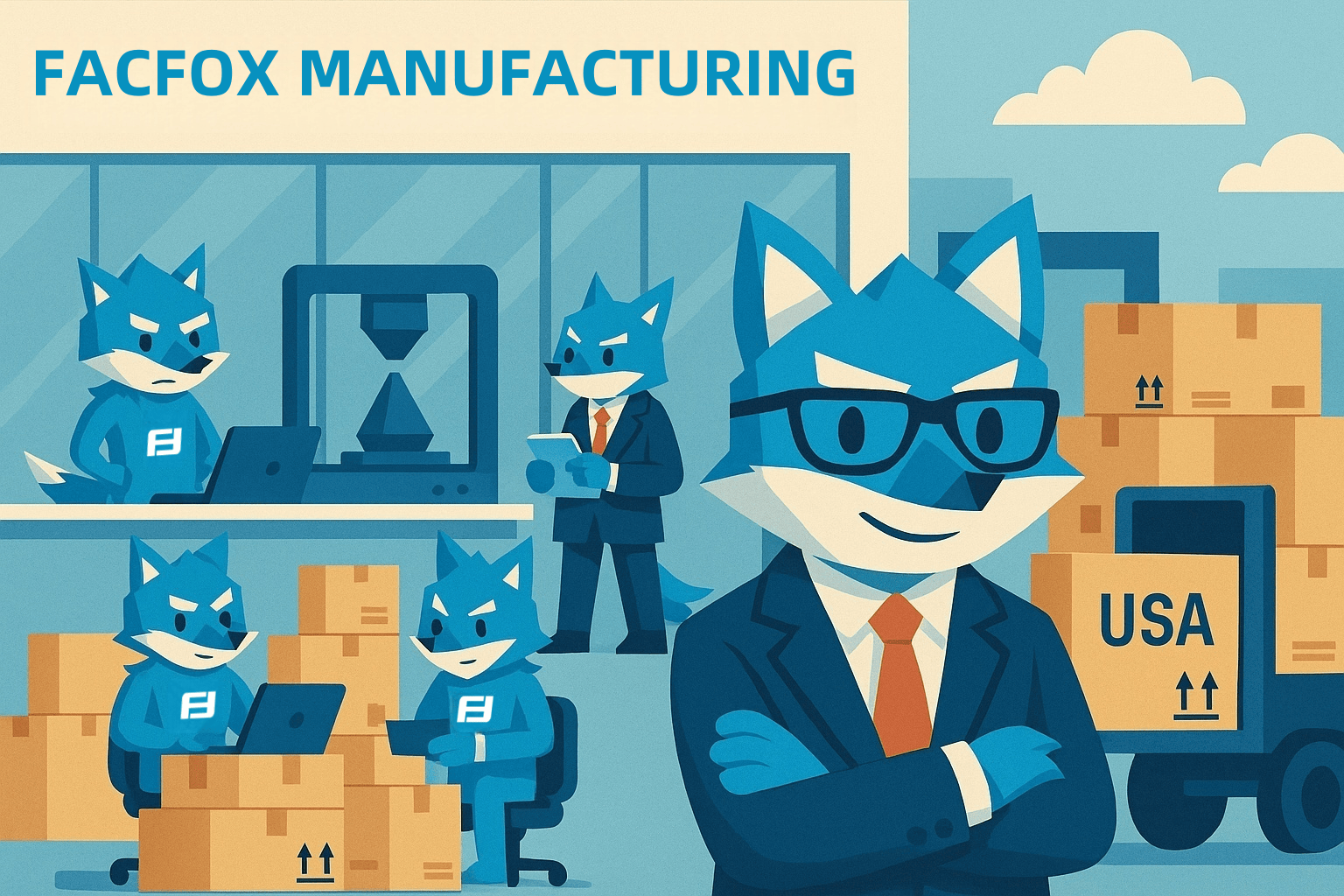
Dear Valued FacFox Customer,
We’re writing to inform you about recent significant changes in US trade policy regarding imports from China, which may affect orders shipped to the United States and potentially impact material costs globally.
We understand these changes can be concerning, and we want to transparently explain the situation and the solutions we are implementing at FacFox.
Tariff Policy Changes & Impacts
Recent adjustments to US tariff policies, particularly concerning goods imported from China, have introduced new considerations for international shipments and manufacturing:
Inevitable Import Tariffs for US Customers
Effective 12:01 a.m. Eastern Daylight Time (EDT) on May 2, 2025, this $800 de minimis exemption is eliminated for goods originating from the People’s Republic of China (PRC) and Hong Kong. This elimination of the de minimis exemption applies comprehensively to all goods valued at $800 or less originating from China or Hong Kong, irrespective of whether they are shipped via international postal services (e.g., China Post/EMS handled by USPS) or commercial carriers (e.g., FedEx, DHL, UPS).
- Postal Shipments (e.g., China Post/EMS shipping via USPS):
For goods valued at $800 or less shipped through the international postal network, the carrier transporting the goods is responsible for collecting and remitting duties to US Customs and Border Protection (CBP). The carrier must elect one of the following two methods for duty calculation:- Method 1: An ad valorem duty rate of 120% applied to the declared value of the postal item containing the goods. This rate underwent several upward revisions from an initial proposal of 30% in early April 2025.
- Method 2: A specific, flat-rate duty per postal item containing goods. This rate is set at $100 effective May 2,2025, and is scheduled to increase to $200 effective June 1, 2025. Similar to the ad valorem rate, this per-item fee was also significantly increased from initial proposals.
A critical point for these low-value postal shipments is that the applicable 120% duty OR the $100/$200 fee is applied in lieu of any other duties, such as Section 301 tariffs, IEEPA tariffs, or Reciprocal tariffs, that might otherwise be applicable to the goods. However, CBP maintains the discretion to require a more complex formal entry process for any postal package, regardless of value.
- Non-Postal Shipments (e.g., Commercial Carriers like FedEx, DHL, UPS, Freight Forwarders):
Shipments arriving via commercial carriers, including those valued at $800 or less that previously qualified for de minimis, are now subject to all applicable duties, taxes, and fees under standard US import procedures. This shift means that multiple layers of tariffs can potentially apply cumulatively (“stack”) to the same imported item. The potential layers include:- Base Duty Rate (0-10%): The standard Most-Favored Nation (MFN) duty rate specified in the Harmonized Tariff Schedule of the United States (HTSUS) for the particular product classification. Base duty rate varies by product, you can check rates of your product with official HTS lookup tools.
- Section 301 Tariffs (0-25%): Additional tariffs imposed on extensive lists of products originating from China, stemming from investigations into technology transfer and intellectual property practices. Current rates typically range from 7.5% to 25% for most affected goods, although some items face higher rates. Many goods commonly manufactured by FacFox, such as items made of plastic (HTS Chapter 39) or machinery and parts (HTS Chapters 84, 85), are included in these Section 301 lists. While some product-specific exclusions from Section 301 tariffs exist, they are limited in scope and subject to change or expiration. To check Section 301 tariff rates, refer to this article: How to Navigate the Section 301 Tariff Process | United States Trade Representative
- IEEPA “Fentanyl” Tariff (20%): An additional 20% ad valorem duty broadly applied to goods imported from China and Hong Kong, implemented under the International Emergency Economic Powers Act (IEEPA) effective March 4, 2025.
- Reciprocal Tariff (125%): A further additional 125% ad valorem duty broadly applied to goods imported from China, Hong Kong, and Macau, implemented effective April 10, 2025, also under IEEPA authority. Certain product categories, such as semiconductors, cell phones, and specific electronics, have been granted exclusions from this particular tariff layer.
The cumulative effect of these “stacked” tariffs for non-postal shipments can be substantial. For example, a typical FacFox manufactured item subject to a 20% IEEPA tariff, 0-25% Section 301 tariff and the 125% Reciprocal tariff would face a total additional duty burden of 145%-170% (20% + (0-25%) + 125%), plus any applicable base HTS duty rate. This calculation confirms that initial concerns about tariffs potentially reaching around 150% are a realistic reflection of the potential impact for many non-postal shipments subject to all applicable layers.
- Base Duty Rate (0-10%): The standard Most-Favored Nation (MFN) duty rate specified in the Harmonized Tariff Schedule of the United States (HTSUS) for the particular product classification.
Potential Delivery Delays for US Customers
The streamlined “Entry Type 86” clearance process, specifically designed for the efficient processing of low-value de minimis shipments, is no longer permitted for goods originating from China and Hong Kong, effective May 2, 2025.
Consequently, all shipments, including those valued below the previous $800 threshold, must now be cleared using more complex standard entry procedures:
- Informal Entry (Type 11): Generally used for shipments valued between $800 and $2,500, this process will now apply to many shipments previously eligible for Type 86. It requires more detailed data submission than Type 86.
- Formal Entry (Type 01): Required for shipments valued over $2,500 and may be mandated by CBP for any shipment regardless of value. This is the most complex entry type, typically necessitating the services of a licensed customs broker.
Both informal and formal entries demand significantly more data than the previous Type 86 process. This includes the precise 10-digit HTSUS classification code for each item, detailed product descriptions, accurate valuation, quantity, country of origin verification, and complete shipper/consignee information. Generally, entries must be filed electronically through CBP’s Automated Commercial Environment (ACE) system; paper submissions are typically not accepted.
Potential Material Cost Increases (Global Impact)
While we strive to absorb fluctuations, materials sourced from specific US-based suppliers (e.g., certain resins or powders from companies like 3D Systems, Formlabs, Stratasys, Markforged) might see price adjustments. This could potentially affect pricing for customers globally, not just in the US.
Increased Administrative Complexity & Customs Scrutiny
The implementation of new tariff rules and declaration requirements will likely lead to more intensive customs clearance procedures. Navigating the new tariff codes, declaration requirements, and additional tariff payment processes adds complexity for both importers and exporters.
Our Solutions to Mitigate Impacts
FacFox is committed to minimizing disruption and providing clarity during this transition. Here’s how we are adapting:
Flexible Declared Value Options
Tariff Deposit System
This deposit will be used to cover the assessed import tariffs. Once the final tariff amount is confirmed, we will promptly process any necessary refunds or contact you if additional payment is required.
Prototyping Declaration Program (HTS 9817.85.01)
Flexible Logistics Solution
We are actively monitoring the situation and exploring alternative logistics strategies to mitigate delays and cost impacts wherever possible.
- Tariff inclusive:
Shipments using this method will be exempt from tariff payments under current regulations. - Extended Transit Time:
Delivery timelines will be longer than express shipping (estimated 10–15 additional business days). - Package Size Restrictions:
This option is currently restricted to very small packages (dimensions and weight thresholds apply). - Implementation Timeline:
We anticipate integrating this option into our order settings by May.10th. Until then, our team will manually assist eligible orders upon request.
Low-cost Material Alternatives
The material library on the FacFox website is being continuously updated to reflect the latest information on performance characteristics, technical specifications, and pricing for both domestic and imported material options. This allows customers to make informed decisions based on their project needs and budget constraints.
Moving Forward Together
Our core mission remains unchanged: to empower creators by making advanced manufacturing technologies accessible and helping bring innovative ideas to fruition.
The new trade regulations undoubtedly present challenges, including potential cost increases and logistical adjustments. We appreciate your understanding and patience as the company navigates this complex international trade landscape!
The company’s focus remains on breaking down barriers to innovation and fostering global cooperation. The belief is in building trust and facilitating creation, not erecting trade walls.
We are committed to working collaboratively with its valued customers to overcome these hurdles. The situation also highlights the resilience offered by agile manufacturing approaches like Manufacturing-as-a-Service (MaaS), which can provide flexibility in navigating supply chain disruptions often exacerbated by trade policy shifts.
Customers with specific questions about how these changes might affect their upcoming orders, or those needing guidance on material selection or customs options, are encouraged to contact our customer support team for assistance.
